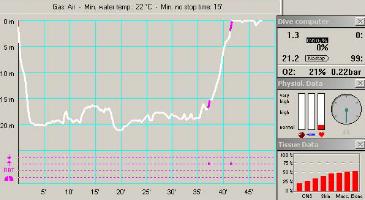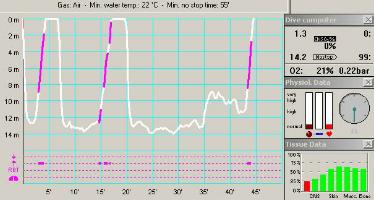Main Homepage: http://www.vancestevens.com
More Scuba: Back to Vance's Scuba Page | Return to Vance's Logbook contents
Navigate logbook: Logbook for 2003 | previous dive | next dive
![]()
Main
Homepage: http://www.vancestevens.com
More
Scuba: Back to Vance's
Scuba Page | Return to Vance's Logbook
contents
Navigate logbook: Logbook for
2003 | previous
dive | next dive
 |
Dive Logs for Vance Stevens PADI open water scuba instructor #64181 Dives 473-474 February 27, 2003 Khor Fakkan, UAE The Inchcape and Martini Rock |
Diving with: 7
Seas
Dive buddies: Bobbi and Michael Ibrahim on his first Rescue
Course dives
Others in dive party: just us
Conditions:
overcast, slight swell rocked boat at anchor
Visibility: 6 - 7
meters or so
Wetsuit: my 5 mil farmer john with the 5 mil Typhoon
top
Weight:10 kg-ish
Diving from:7 Seas dive boat
Thursday, February 27, 2003
My 473rd Logged Dive since 1991
Dive site: The 'new' wreck Inchcape
Training
conducted: Michael Ibrahim's Rescue Diver Training Exercises 2 (Panicked
Diver underwater) and 4 (distressed diver underwater and AAS ascent)
Data from dive computer:
Interval on computer from previous dive: nil, first dive of day
Time down on dive computer: 13:25
Max depth: 21.2 meters
Time
started up from chart: 36 min showing on computer at time of ascent
Dive
time from computer: 41 min
Min Temp: 22 degrees centigrade
Nitrox 21%
(normal air), no deco
PSI/Bar in: 200 in main tank
PSI/Bar out: 70 bar on main tank

Description of dive:
Mohammed of 7-Seas graciously provided us a boat for this dive and allowed us to come at our leisure on a Thursday. We left Abu Dhabi at 8:15 and due to truck traffic en route did not arrive at KF until after noon. Still we managed to start our dive by 1:30.
The Inchcape is a wreck sunk just a year or so ago by Hassan Jabber and others to create another dive site near Martini Rock. It was a brilliant idea because not only will it take pressue off Martini but also it's attracting corals and fish life and will eventually be an equally interesting place to dive. Already, it's encrused in colorful soft corals and if you look carefully you can find green and baby honeycomb morays and lion fish there. There were a number of cuttlefish resting in the sand humps off the eastern side of the hull, camoflaged. There were batfish on the bow and a grouper or two lurking where we hoped to find rays (but didn't). There is a hold amidships very easy to swim into and a companionway with ambient light at either end, a good place for beginners to make a penetration. The wheelhouse has glass in the windows still. The wreck is covered with schools of fish that look serenely pretty when viewed above the soft coral-scapes.
It was Bobbi's and my first dive with Michael and though he seemed to be comfortable and qualified with diving, as we didn't know his diving habits we took it easy. I kept the training aspects to a minimum. We practiced dealing with tired and panicked divers, how to make contact and reassure and signal correct breathing. For panicked divers we practiced coming around behind and cradling the tank. The last exercise was an alternate air source ascent, with Michael conducting Bobbi. It happened to be the first time both Michael and Bobbi were wearing their new dive computers, so the alarms were going off all the time, taking them by surprise but forcing them to regulate their ascent. With the two of them breathing on Ibrahim's tank, its pressure went from 50 bar (I had checked at the bottom) to just 10 at the surface, a bit much for what you might expect for a minute long ascent from 18 meters, but a good reminder to be sure and start AAS exercises with no less than 50 bar in a student's tank.
Another odd thing that happened here was that Bobbi got a severe mask squeeze. She went in too light and had trouble descending, and in the process of upending and finning down, she neglected at first to blow into her mask till too laste. She didn't notice a problem till halfway home, but was shocked to see blood at the surface of her eyes, and pooling in bags below them. We checked the PADI Encyclopedia of Diving on return home and found that this looks worse than it is, that victims are often unaware of their condition until they look in the mirror, and that mask squeeze effects usually pass without complication. It most often happens with beginners or with divers who have just changed masks, and guess who had just replaced her mask!
Pressure group out, from tables or wheel: Looking at the tables at 36 min for a 22 meter dive (ndl 37 min) we figured we were S divers on exit. After an hour we would be G divers. We figured our next dive on Martini Rock to be 47 min if we stayed above 16 meters.
Surface interval: Training conducted: Michael Ibrahim's Rescue Diver Training Exercises 1 (Tired Diver), 2 (Panicked Diver at the surface), 3 (Response from boat)
My 474th Logged Dive since 1991
Dive site: Martini Rock
Training
conducted: Michael Ibrahim's Rescue Diver Training Exercises 5 (search
for missing diver), and 6 (surfacing unconscious diver)
Data from dive computer:
Surface interval: 1:00
Pressure group at start of
repetitive dive: G
Time down on dive computer: 15:14
Max depth: 14.2 meters
Time
started up from chart: 43 min
Dive time from computer: 37 min (deducts
surface time)
Min Temp: 22 degrees centigrade
Nitrox 21% (normal air), no
deco
PSI/Bar in: 200 in main tank
PSI/Bar out: 70 bar on main tank

Description of dive:
Bobbi was feeling too cold to be comfortable with a second dive, so Michael and I set up a scenario where I would go diving with a banana, lose my buddy, and call him over to help me find him We envisaged that a diver with a missing buddy might surface after a minute, and when no buddy appeared, call the boat.for assistance. That way, if the buddy did reappear (after divers had gone looking for him), the boat would be there to assist and recall the rescue divers. We figured this was a plausible scenario which would obviate the need to send a skin diver to mark the spot, as was suggested in the manual.
I started diving on my own and during my dive I tucked my banana under a pipe I found in sand at the bottom (bananas I discovered are otherwise buoyant). I then finned north 20 or 30 meters to the rock, surfaced, and called for help.
Michael entered the water and finned to where I was. He asked me what the current was like. I told him I had noticed a slight southerly current and at that point noticed I had also drifted off the rock to the south. I swam back toward the rock but Michael wanted to start the search where he had found me (correctly or no, anyone's call, to compensate for current), so we descended some meters apart.
At bottom, Michael took out his slate and started sketching out a search plan. Meanwhile I deployed my sausage marker buoy but found nothing to attach it to there in the sand. Both these actions I thought at the time were unnecessarily time consuming considering a diver starved of oxygen for 10 minutes would have irreversable brain damage, but as we went about our search I reconsidered and felt that both actions in fact contributed to the efficiency of the search and might have saved time in the long run.
Michael started his search in a square that took him near the rock, and there I was able to find a way to place my reel with the buoy attached. As he continued his search (the diagram for which he also left on my slate) I saw he was making a U pattern to the southwest (and I knew the banana was somewhere to the southeast). I let him go for a couple of minutes till he was too far out and then suggested we return to the rock. I found the rock on an apprx compass heading but found no marker buoy so I suggested we surface. At the surface we saw the buoy just ten meters to the east. Michael thought the buoy might have drifted but I thought it was attached ok (which it turned out to be). In any event, it was very good to have it there because it did fix a point in our search to allow us to restart at a logical point. At the surface we discussed how we would then proceed. I suggested that the U might be a good plan if you had several divers searching but for the two of us over a wide area a square might be better. I also pointed out that the current we had on that day was unlikely to sweep a diver away (or a banana under a pipe). So we agreed to continue with a square. Meanwhile we had both learned valuable lessons about coordination in the silent world underwater, esp important when a life is at stake (or in this case, a banana).
We descended near the marker buoy and continued. Michael initated his square a bit far to the east so I took the role of the dive buddy who might steer a rescuer in a more intutitively productive direction, suggesting in gestures that I had last seen my buddy more over this way. We then conducted a U to the west. I was assisted as Michael could not have been by the presence of some detritus in the region where the banana had last been seen. The important thing is we coordinated our efforts and searched systematically and did indeed find the banana on that pass, whereup Michael removed his reg and administered it two rescue breaths. Or maybe he was eating it. Not sure. There was nothing in the manual to tell me how to deal with that particular training scenario underwater.
We then compassed back to the rock and recovered my reel which I wound in as we finned up and over the rock. We didn't have much time to enjoy the rock, but we found an electric ray, a few morays, and a scorpion fish. When Michael was down to 50 bar I lost conciousness, and he responded by conducting me to the surface. When he didn't hold my reg in (to vent our bcds) I lost it and let it fall away in a rush of bubbles, which reminded him to keep that sucker in my mouth. Maybe an unconscious diver wouldn't lose a reg (I had to consciously expell it).
All in all a successful day out, a learning experience for all.
Pressure group out, from tables or wheel: n/a
|
For comments,
suggestions, or further information on this page, Last updated: December 26, 2003 in Hot Metal Pro 6.0 |